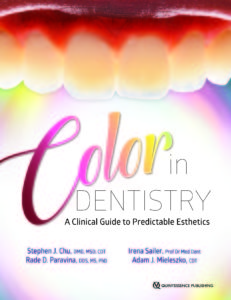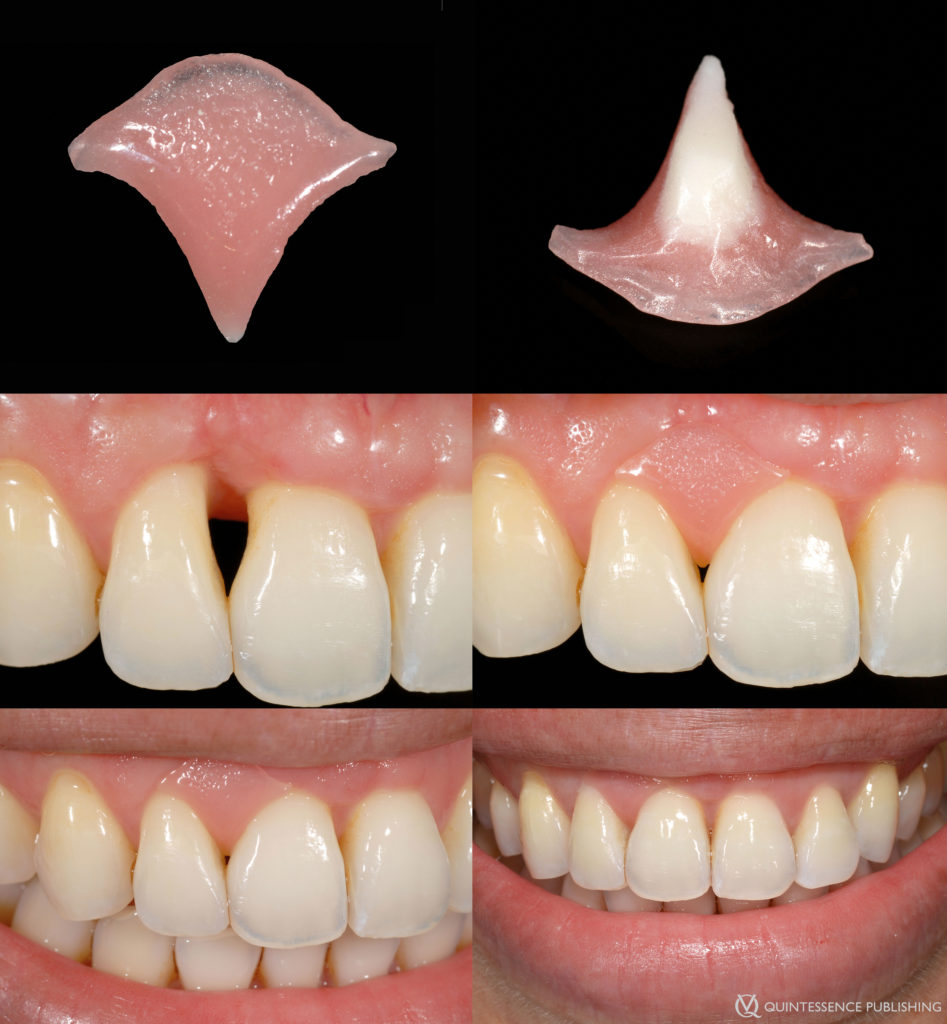Picture the scene: A new patient has been referred to your office for an esthetic treatment consultation. The patient’s mouth is an Easter egg basket of assorted colors and issues: some veneers here, an implant there, a post and core–treated tooth next to that, and a few missing papillae sprinkled—or not sprinkled—on top. None of it matches, and the patient understandably desires a more cohesive esthetic appearance. Enter you. How do you proceed?
 If you’ve ever watched a home-remodeling television show, you know the first step is usually to tear everything out but the walls and roof in order to start fresh and work toward a beautiful, modern end result. Unfortunately, the human mouth is not quite as resilient. Patients often show up with a guestbook in their mouth signed by every dentist they’ve ever visited, and even the most advanced technician can have trouble matching color between different materials and thicknesses. Drs Stephen J. Chu, Rade D. Paravina, and Irena Sailer and master ceramist Adam J. Mieleszko confront these issues and more in their new book, Color in Dentistry: A Clinical Guide to Predictable Esthetics.
If you’ve ever watched a home-remodeling television show, you know the first step is usually to tear everything out but the walls and roof in order to start fresh and work toward a beautiful, modern end result. Unfortunately, the human mouth is not quite as resilient. Patients often show up with a guestbook in their mouth signed by every dentist they’ve ever visited, and even the most advanced technician can have trouble matching color between different materials and thicknesses. Drs Stephen J. Chu, Rade D. Paravina, and Irena Sailer and master ceramist Adam J. Mieleszko confront these issues and more in their new book, Color in Dentistry: A Clinical Guide to Predictable Esthetics.
Color Matching with Discolored Substrates
One case described in the book involves the replacement of three crowns on nonvital anterior maxillary teeth previously treated with metal post-and-core buildups. The stumps were significantly discolored due to the large posts and translucent restoration materials.
“In a specific situation like this,” Dr Sailer explains, “the old post-and-core buildups were not removed because there was a risk of catastrophic root fracture upon removal and no indication to renew the endodontic treatment. Current material options made it possible to mask the metallic substructure and achieve an esthetic result.”

The old crowns were removed and displayed big metal posts that led to a strong discoloration of the composite cores. The team discussed removing the post-and-core buildups but decided not to do so because of the high risk for fracture of the roots. Because the patient was financially limited, the team offered him less costly monolithic chairside restorations based on a resin-based hybrid material (Lava Ultimate, 3M ESPE). Unfortunately, the raw and unpolished “biscuit try-in” of the monolithic crowns were not esthetic at all, and it became clear that even using a stain and glaze kit offered by the manufacturer, the desired esthetic outcome would not be reached. After discussing this esthetic limitation with the patient, he agreed to the extra cost for a small cutback and buccal veneering of the crowns to better match the natural reference tooth. (Case rehabilitation performed in collaboration with Vincent Fehmer, MDT.)
In this and similar cases, clinicians can often modify the treatment in order to achieve successful esthetic results using white resin, ceramic, and glass-ceramic materials. But what about cases where the discoloration is too strong to be masked with such translucent materials?
In the book, the authors describe a case involving the replacement of crowns on both of the patient’s maxillary central incisors where the left was nonvital and discolored and the right was vital and nondiscolored. Complicating the treatment planning and material selection was the patient’s insistence on all-ceramic restorations rather than metal-ceramic—the two original 20- to 30-year-old metal-ceramic crowns were opaque and not natural-looking, not to mention unsuccessful at masking the cervical discoloration of the tooth root. However, even after placing opaque zirconia frameworks, the technician was not able to fully mask the discolored left central incisor. Luckily, the technician had also made a pair of metal-ceramic crowns that the team compared at try-in, and the patient ended up agreeing with the team that the metal-ceramic crowns were better after all. The metal-ceramic crowns allowed the technician to start with the same gray framework color on both teeth, while also allowing for a thinner framework with a stronger value of opacity and larger ceramic shoulders to better reflect the veneering ceramic.

In this case, metal-ceramic crowns allowed the technician to start from the same gray framework color on both crowns, whereas zirconia frameworks failed to adequately mask the stump discoloration. (Case rehabilitation performed in collaboration with Walter Gebhardt, DT.)
Restoring Esthetics Using Pink Restorative Materials
Patients’ teeth are not the only reason they may be displeased with previous dental treatment. One of the newest and most exciting mediums of esthetic dentistry is the use of pink restorative materials, which is opening up a new range of treatment possibilities for soft tissue defects. Previously, the standard options for missing papillae were surgical soft tissue augmentation or forced orthodontic eruption. These options are time-consuming and costly and in some cases may not be possible or recommended due to unmet biologic parameters. Advances in both materials and techniques are making the use of pink restorative materials a reliable solution.
 “Pink restorative materials can be used in patient situations where there are contraindications for surgery or when the patient simply does not want surgery,” Dr Sailer, who has used pink restorative materials in her practice for over a decade, explains. “They can also be done in complicated clinical situations with huge vertical and horizontal defects. The ceramic is smooth and polished at the surface—exactly like tooth-colored veneering ceramic. We design the pink porcelain to be cleanable and instruct patients on how to perform oral hygiene around reconstructions.” Pink restorative materials can also be used to restore missing papillae, which are especially common after single-implant therapy.
“Pink restorative materials can be used in patient situations where there are contraindications for surgery or when the patient simply does not want surgery,” Dr Sailer, who has used pink restorative materials in her practice for over a decade, explains. “They can also be done in complicated clinical situations with huge vertical and horizontal defects. The ceramic is smooth and polished at the surface—exactly like tooth-colored veneering ceramic. We design the pink porcelain to be cleanable and instruct patients on how to perform oral hygiene around reconstructions.” Pink restorative materials can also be used to restore missing papillae, which are especially common after single-implant therapy.
In a case where the patient presented with multiple adjacent implants placed from maxillary right canine to left central incisor and with inverted tooth axes, insufficient overjet and overbite, a reverse smile line, and lack of interproximal papillae, the presenting restorations “possessed all the dilemmas associated with not using pink restorative materials and only using white ceramics to compensate for esthetic deficiencies,” according to the authors. A treatment plan was devised that included ceramic veneers on the right second premolar and left first premolar, single crowns on the right first premolar and left lateral incisor, and an all-ceramic fixed dental prosthesis for the right canine to left central incisor. Importantly, pink restorative material was included on all but the two veneers. This tapered approach allowed the team to redefine the patient’s entire smile in a way that without the use of pink restorative materials would have required more invasive procedures such as orthognathic surgery.

Putting Everything Together
A final example involves matching dissimilar restoration and material types with pink ceramics. The patient, a 28-year-old woman, presented with multiple congenitally missing maxillary teeth (right canine and left lateral incisor), an impacted maxillary left canine, and existing composite direct veneer restorations on the maxillary right first premolar to central incisor and left primary lateral incisor to first premolar placed more than two decades ago. Several esthetic issues were present, including a canted transverse plane with lack of maxillary incisal tooth exposure. The maxillary restorative arch form was constricted due to the lack of intra-arch width development without the eruption of the permanent dentition, and previous composite bonding of the maxillary right first premolar to the left first premolar was disharmonious.
During the “tear-out” phase of this oral renovation, the old composite restorations were removed. The team also extracted the primary left lateral incisor and the impacted canine. The right incisors required esthetic crown lengthening to restore the proper length relative to width. The definitive restorations included preparationless veneers on the second premolars, metal-ceramic implant restorations on the right canine and left lateral incisor and canine, single metal-ceramic full-coverage crowns on the first premolars, and extended all-ceramic layered feldspathic veneer restorations on the right incisors and left central incisor.
This case involved esthetic integration with regard to individual tooth proportion, arch form, and color matching between dissimilar materials (metal-ceramics vs all-ceramics) and restoration types (full-coverage crowns versus veneers). Pink-colored ceramics replaced the height of the lost interproximal papilla between the left lateral incisor and canine. The definitive restorations also blended with the patient’s mandibular dentition, on which she had performed minor vital bleaching. The end result is a harmonious, well-proportioned smile with improved function that, most importantly, the patient was very happy with.

A Guide to Success
Many restorative dentists and laboratory technicians can fabricate a beautiful restoration in an ideal clinical situation. However, successful esthetic results are much more elusive when the patient has soft tissue defects or when the case involves previous nonesthetic restorations. Color in Dentistry: A Clinical Guide to Predictable Esthetics guides clinicians through that renovation process and provides insight on all things color. You may not be the last entry in your patient’s dental guestbook, but with results like these you can be the most memorable and effective.
 Stephen J. Chu, DDS, MSD, CDT, MDT, is an associate clinical professor in the Ashman Department of Periodontology and Implant Dentistry and the Department of Prosthodontics as well as the director of esthetic education at the New York University College of Dentistry. He has published more than 40 articles and given lectures nationally and internationally on the subjects of esthetic, restorative, and implant dentistry. Dr Chu is a coauthor of the book Fundamentals of Color: Shade Matching and Communication in Esthetic Dentistry, Second Edition (Quintessence, 2011) and is on the editorial review board of several peer-reviewed dental journals. He is the recipient of the Peter Scharer Distinguished Lecturer Award from the European Academy of Esthetic Dentistry and the Lloyd L. Miller Distinguished Lecturer Award from the Society for Color and Appearance in Dentistry. Dr Chu maintains a private practice limited to fixed prosthodontics, esthetic dentistry, and implant dentistry in New York City.
Stephen J. Chu, DDS, MSD, CDT, MDT, is an associate clinical professor in the Ashman Department of Periodontology and Implant Dentistry and the Department of Prosthodontics as well as the director of esthetic education at the New York University College of Dentistry. He has published more than 40 articles and given lectures nationally and internationally on the subjects of esthetic, restorative, and implant dentistry. Dr Chu is a coauthor of the book Fundamentals of Color: Shade Matching and Communication in Esthetic Dentistry, Second Edition (Quintessence, 2011) and is on the editorial review board of several peer-reviewed dental journals. He is the recipient of the Peter Scharer Distinguished Lecturer Award from the European Academy of Esthetic Dentistry and the Lloyd L. Miller Distinguished Lecturer Award from the Society for Color and Appearance in Dentistry. Dr Chu maintains a private practice limited to fixed prosthodontics, esthetic dentistry, and implant dentistry in New York City.
 Rade D. Paravina, DDS, MS, PhD, is a tenured Professor at the University of Texas School of Dentistry at Houston and Director of the Houston Center for Biomaterials and Biomimetics. He is founder and past president of the Society for Color and Appearance in Dentistry (SCAD) and received the 2011 E. B. Clark Award from SCAD in 2011. He is the 2014 recipient of the Jerome M. and Dorothy Schweitzer Research Award of the Greater New York Academy of Prosthodontics. Dr Paravina is a fellow of the American Academy of Esthetic Dentistry, the American Association for Dental Research, and SCAD. Dr Paravina coauthored Fundamentals of Color: Shade Matching and Communication in Esthetic Dentistry, Second Edition (Quintessence, 2011) and Esthetic Color Training in Dentistry (Elsevier, 2004) and has contributed to 15 book chapters, 2 software programs, 1 educational CD, and more than 220 peer-reviewed publications. He serves as associate editor of the Journal of Esthetic and Restorative Dentistry and editorial review board member of several other peer-reviewed dental journals. Dr Paravina lectures nationally and internationally on various topics associated with color and appearance in esthetic dentistry.
Rade D. Paravina, DDS, MS, PhD, is a tenured Professor at the University of Texas School of Dentistry at Houston and Director of the Houston Center for Biomaterials and Biomimetics. He is founder and past president of the Society for Color and Appearance in Dentistry (SCAD) and received the 2011 E. B. Clark Award from SCAD in 2011. He is the 2014 recipient of the Jerome M. and Dorothy Schweitzer Research Award of the Greater New York Academy of Prosthodontics. Dr Paravina is a fellow of the American Academy of Esthetic Dentistry, the American Association for Dental Research, and SCAD. Dr Paravina coauthored Fundamentals of Color: Shade Matching and Communication in Esthetic Dentistry, Second Edition (Quintessence, 2011) and Esthetic Color Training in Dentistry (Elsevier, 2004) and has contributed to 15 book chapters, 2 software programs, 1 educational CD, and more than 220 peer-reviewed publications. He serves as associate editor of the Journal of Esthetic and Restorative Dentistry and editorial review board member of several other peer-reviewed dental journals. Dr Paravina lectures nationally and internationally on various topics associated with color and appearance in esthetic dentistry.
 Irena Sailer, Prof Dr med dent, is professor and chair of the Division of Fixed Prosthodontics and Biomaterials at the University of Geneva in Switzerland. She has served as a visiting scholar in the Department of Biomaterials and Biomimetics of the New York University College of Dentistry and currently holds an adjunct associate professorship of restorative dentistry at the University of Pennsylvania School of Dental Medicine. Dr Sailer is certified as a specialist in prosthodontics by the Swiss Society for Reconstructive Dentistry and in dental implantology by the Swiss Society for Dentistry.
Irena Sailer, Prof Dr med dent, is professor and chair of the Division of Fixed Prosthodontics and Biomaterials at the University of Geneva in Switzerland. She has served as a visiting scholar in the Department of Biomaterials and Biomimetics of the New York University College of Dentistry and currently holds an adjunct associate professorship of restorative dentistry at the University of Pennsylvania School of Dental Medicine. Dr Sailer is certified as a specialist in prosthodontics by the Swiss Society for Reconstructive Dentistry and in dental implantology by the Swiss Society for Dentistry.
 Adam J. Mieleszko, CDT, graduated in 1997 from New York City Technical College with a degree in dental laboratory technology and received certification in dental ceramics in 2000. Since then he has worked in close collaboration with leading prosthodontists in the field. Mr Mieleszko is a coauthor of the book Fundamentals of Color: Shade Matching and Communication in Esthetic Dentistry, Second Edition (Quintessence, 2011) and has contributed to numerous clinical and technical articles in industry journals. He is a master ceramist based in New York City.
Adam J. Mieleszko, CDT, graduated in 1997 from New York City Technical College with a degree in dental laboratory technology and received certification in dental ceramics in 2000. Since then he has worked in close collaboration with leading prosthodontists in the field. Mr Mieleszko is a coauthor of the book Fundamentals of Color: Shade Matching and Communication in Esthetic Dentistry, Second Edition (Quintessence, 2011) and has contributed to numerous clinical and technical articles in industry journals. He is a master ceramist based in New York City.

Pingback: One Surgery, One Time: Revolutionizing Single-Tooth Implant Therapy | Quintessence Publishing Blog